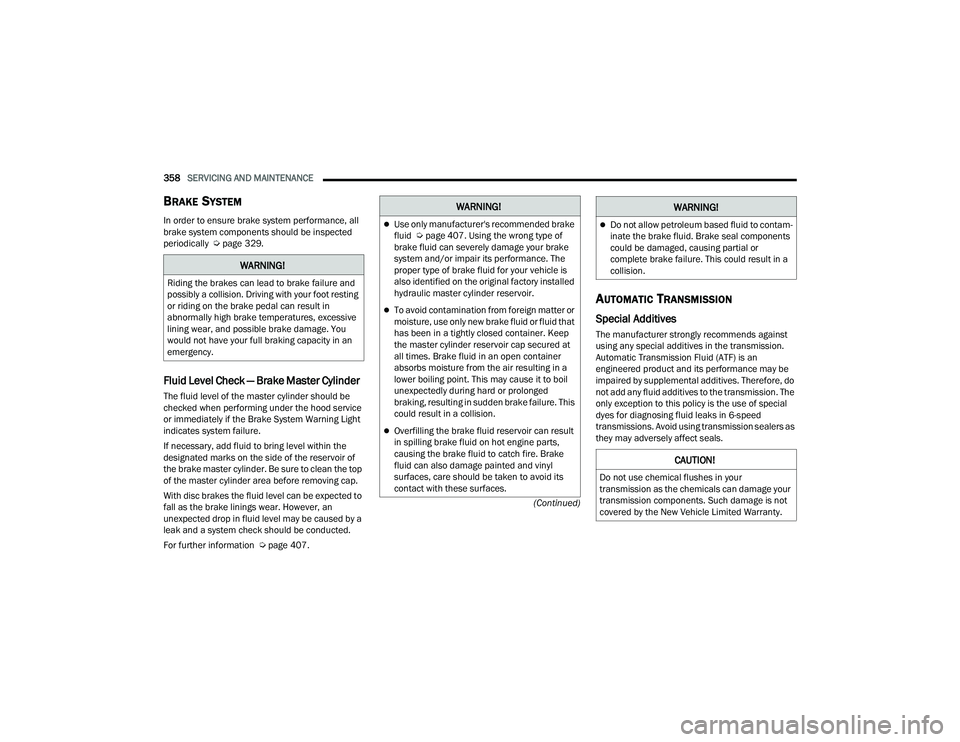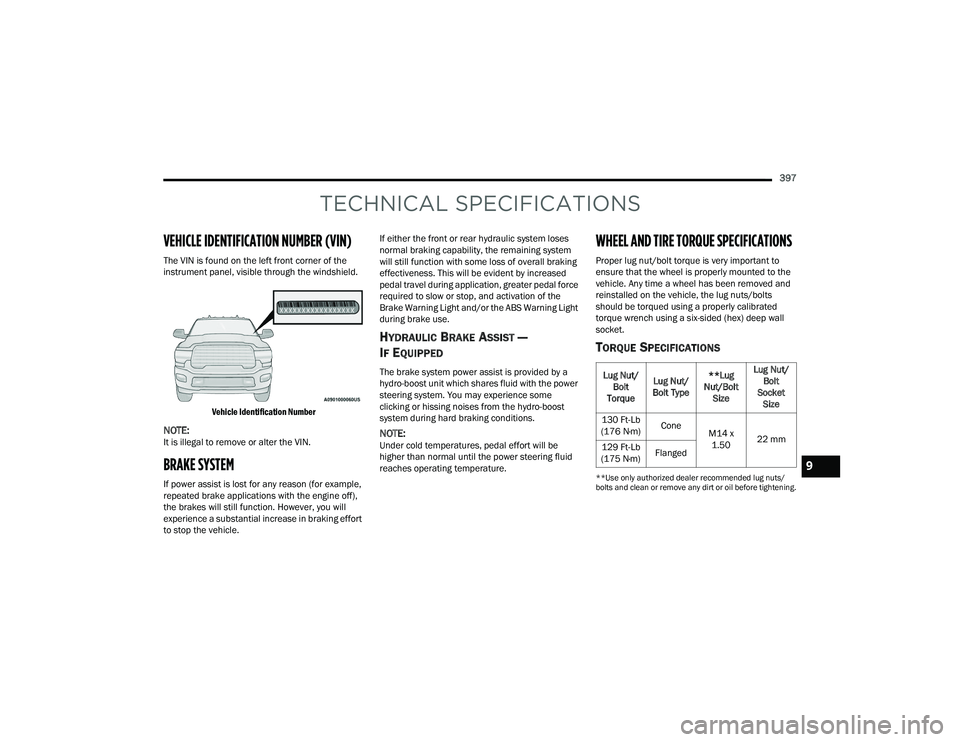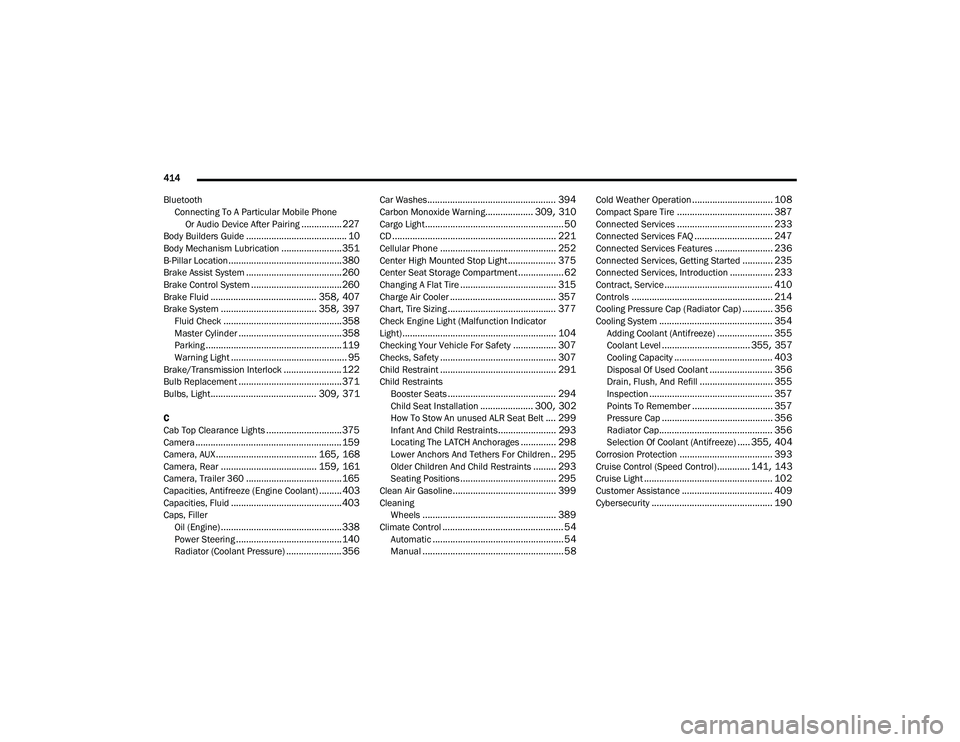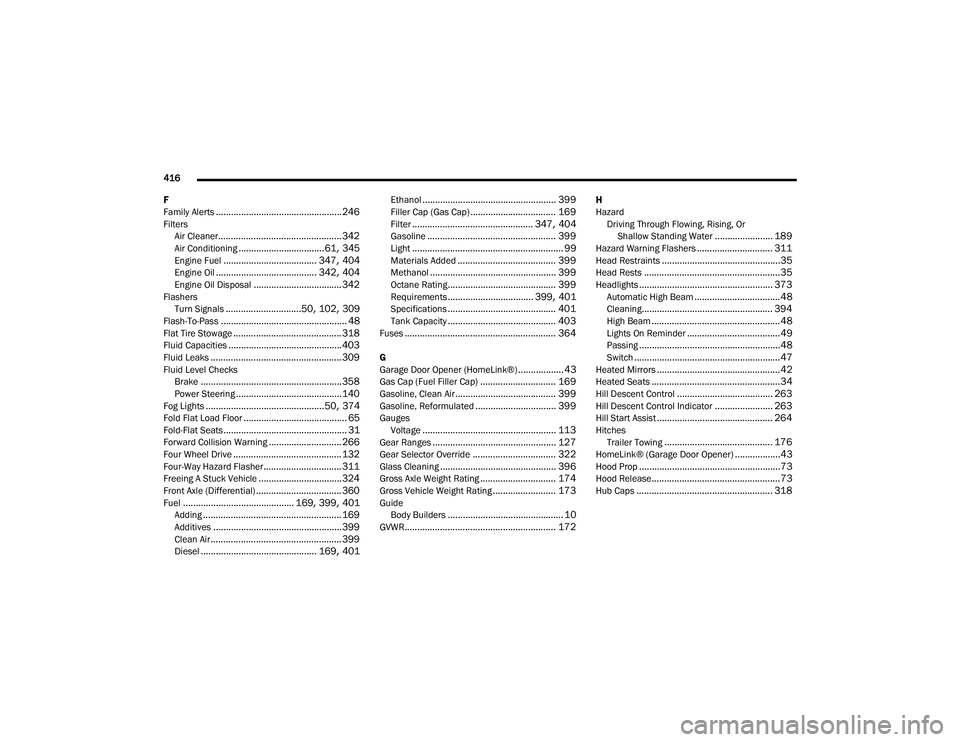brake fluid RAM CHASSIS CAB 2022 Owner's Manual
[x] Cancel search | Manufacturer: RAM, Model Year: 2022, Model line: CHASSIS CAB, Model: RAM CHASSIS CAB 2022Pages: 428, PDF Size: 20.18 MB
Page 353 of 428

SERVICING AND MAINTENANCE351
the EPA Heavy Duty Diesel Engine Emissions
Standards. These systems are seamlessly
integrated into your vehicle and managed by the
Cummins® Powertrain Control Module (PCM). The
PCM manages engine combustion to allow the
exhaust system’s catalyst to trap and burn
Particulate Matter (PM) pollutants, with no input or
interaction on your part.
If the engine is allowed to idle or the truck is driven
on low engine speed drive cycles for more than two
hours, the system will automatically enter an
emissions operating mode that will increase the
engine idle speed to 1,050 RPM. While in this
mode, which is designed to help maintain the
Diesel Particulate Filter, the engine idle speed will
return to normal when the brake pedal is applied.
A small change in engine tone or a slight change in
engine performance while accelerating may also
be noticeable at speeds below 20 mph (32 km/h).
This operating mode may last for up to an hour of
idle time, or around 20 minutes of driving time.
Additionally, your vehicle has the ability to alert you
to additional maintenance required on your truck
or engine Ú page 81.
DIESEL EXHAUST FLUID (DEF)
DEF sometimes known simply by the name of its
active component, UREA—is a key component of
Selective Catalytic Reduction (SCR) systems, which
help diesel vehicles meet stringent emission
regulations. DEF is a liquid reducing agent that
reacts with engine exhaust in the presence of a
catalyst to convert smog-forming nitrogen oxides
(NOx) into harmless nitrogen and water vapor
Úpage 404.
You can receive assistance in locating DEF by
contacting an authorized dealer.
BODY LUBRICATION
Locks and all body pivot points, including such
items as seat tracks, door hinge pivot points and
rollers, liftgate, tailgate, decklid, sliding doors and
hood hinges, should be lubricated periodically with
a lithium-based grease, such as Mopar® Spray
White Lube to ensure quiet, easy operation and to protect against rust and wear. Prior to the
application of any lubricant, the parts concerned
should be wiped clean to remove dust and grit;
after lubricating excess, oil and grease should be
removed. Particular attention should also be given
to hood latching components to ensure proper
function. When performing other underhood
services, the hood latch, release mechanism and
safety catch should be cleaned and lubricated.
The external lock cylinders should be lubricated
twice a year, preferably in the Autumn and Spring.
Apply a small amount of a high quality lubricant,
such as Mopar® Lock Cylinder Lubricant directly
into the lock cylinder.
WINDSHIELD WIPER BLADES
Clean the rubber edges of the wiper blades and the
windshield periodically with a sponge or soft cloth
and a mild nonabrasive cleaner. This will remove
accumulations of salt or road film.
Operation of the wipers on dry glass for long
periods may cause deterioration of the wiper
blades. Always use washer fluid when using the
wipers to remove salt or dirt from a dry windshield.
Avoid using the wiper blades to remove frost or ice
from the windshield. Keep the blade rubber out of
contact with petroleum products such as engine
oil, gasoline, etc.
WARNING!
A hot exhaust system can start a fire if you park
over materials that can burn. Such materials
might be grass or leaves coming into contact
with your exhaust system. Do not park or oper
-
ate your vehicle in areas where your exhaust sys -
tem can contact anything that can burn.
8
22_DPF_OM_EN_USC_t.book Page 351
Page 360 of 428

358SERVICING AND MAINTENANCE
(Continued)
BRAKE SYSTEM
In order to ensure brake system performance, all
brake system components should be inspected
periodically Úpage 329.
Fluid Level Check — Brake Master Cylinder
The fluid level of the master cylinder should be
checked when performing under the hood service
or immediately if the Brake System Warning Light
indicates system failure.
If necessary, add fluid to bring level within the
designated marks on the side of the reservoir of
the brake master cylinder. Be sure to clean the top
of the master cylinder area before removing cap.
With disc brakes the fluid level can be expected to
fall as the brake linings wear. However, an
unexpected drop in fluid level may be caused by a
leak and a system check should be conducted.
For further information Ú page 407.
AUTOMATIC TRANSMISSION
Special Additives
The manufacturer strongly recommends against
using any special additives in the transmission.
Automatic Transmission Fluid (ATF) is an
engineered product and its performance may be
impaired by supplemental additives. Therefore, do
not add any fluid additives to the transmission. The
only exception to this policy is the use of special
dyes for diagnosing fluid leaks in 6-speed
transmissions. Avoid using transmission sealers as
they may adversely affect seals.
WARNING!
Riding the brakes can lead to brake failure and
possibly a collision. Driving with your foot resting
or riding on the brake pedal can result in
abnormally high brake temperatures, excessive
lining wear, and possible brake damage. You
would not have your full braking capacity in an
emergency.
WARNING!
Use only manufacturer's recommended brake
fluid Úpage 407. Using the wrong type of
brake fluid can severely damage your brake
system and/or impair its performance. The
proper type of brake fluid for your vehicle is
also identified on the original factory installed
hydraulic master cylinder reservoir.
To avoid contamination from foreign matter or
moisture, use only new brake fluid or fluid that
has been in a tightly closed container. Keep
the master cylinder reservoir cap secured at
all times. Brake fluid in an open container
absorbs moisture from the air resulting in a
lower boiling point. This may cause it to boil
unexpectedly during hard or prolonged
braking, resulting in sudden brake failure. This
could result in a collision.
Overfilling the brake fluid reservoir can result
in spilling brake fluid on hot engine parts,
causing the brake fluid to catch fire. Brake
fluid can also damage painted and vinyl
surfaces, care should be taken to avoid its
contact with these surfaces.
Do not allow petroleum based fluid to contam -
inate the brake fluid. Brake seal components
could be damaged, causing partial or
complete brake failure. This could result in a
collision.
CAUTION!
Do not use chemical flushes in your
transmission as the chemicals can damage your
transmission components. Such damage is not
covered by the New Vehicle Limited Warranty.
WARNING!
22_DPF_OM_EN_USC_t.book Page 358
Page 361 of 428

SERVICING AND MAINTENANCE359
Fluid Level Check — 8-Speed Transmission
The fluid level is preset at the factory and does not
require adjustment under normal operating
conditions. Routine fluid level checks are not
required, therefore the transmission has no
dipstick. An authorized dealer can check your
transmission fluid level using special service tools.
If you notice fluid leakage or transmission
malfunction, visit an authorized dealer
immediately to have the transmission fluid level
checked. Operating the vehicle with an improper
fluid level can cause severe transmission damage.
Fluid Level Check — 6-Speed Transmission
It is best to check the fluid level when the
transmission is at normal operating temperature
(158-176°F / 70-80°C). This normally occurs
after at least 15 miles (25 km) of driving. At normal
operating temperature the fluid cannot be held
comfortably between the fingertips. You can read
the transmission sump temperature in the
instrument cluster screen Ú page 81.Use the following procedure to check the
transmission fluid level properly:
1. Monitor the transmission temperature using
the instrument cluster display, and operate
the vehicle as required to reach the normal
operating temperature. If the transmission is
not functioning properly, or the vehicle cannot
be driven, see the NOTE and CAUTION below
about checking the fluid level at colder
temperatures.
2. Park the vehicle on level ground.
3. Run the engine at normal idle speed for at least 60 seconds, and leave the engine
running for the rest of this procedure.
4. Fully apply the parking brake, and press the brake pedal.
5. Place the gear selector momentarily into each gear position (allowing time for the
transmission to fully engage in each position),
ending with the transmission in PARK.
6. Remove the dipstick, wipe it clean and reinsert it until seated.
7. Remove the dipstick again and note the fluid level on both sides. The fluid level reading is
only valid if there is a solid coating of oil on
both sides of the dipstick. Note that the holes
in the dipstick will be full of fluid if the actual
level is at or above the hole. The fluid level
should be between the “HOT” (upper) reference holes on the dipstick at normal
operating temperature. If the fluid level is low,
add fluid through the dipstick tube to bring it to
the proper level.
Do not overfill. Use ONLY the
specified fluid Ú page 407. After adding any
quantity of oil through the dipstick tube, wait a
minimum of two minutes for the oil to fully
drain into the transmission before rechecking
the fluid level.
NOTE:If it is necessary to check the transmission below
the operating temperature, the fluid level should
be between the two “COLD” (lower) holes on the
dipstick with the fluid at 60-70°F / 16-21°C. Only
use the COLD region of the dipstick as a rough
reference when setting the fluid level after a trans -
mission service or fluid change. Re-check the fluid
level, and adjust as required, once the trans -
mission reaches normal operating temperature.
8. Reinsert the dipstick. Check for leaks. Release the parking brake.
CAUTION!
If a transmission fluid leak occurs, visit an
authorized dealer immediately. Severe
transmission damage may occur. An authorized
dealer has the proper tools to adjust the fluid
level accurately.
CAUTION!
If the fluid temperature is below 50°F (10°C) it
may not register on the dipstick. Do not add fluid
until the temperature is elevated enough to
produce an accurate reading. Run the engine at
idle, in PARK, to warm the fluid.
8
22_DPF_OM_EN_USC_t.book Page 359
Page 399 of 428

397
TECHNICAL SPECIFICATIONS
VEHICLE IDENTIFICATION NUMBER (VIN)
The VIN is found on the left front corner of the
instrument panel, visible through the windshield.
Vehicle Identification Number
NOTE:It is illegal to remove or alter the VIN.
BRAKE SYSTEM
If power assist is lost for any reason (for example,
repeated brake applications with the engine off),
the brakes will still function. However, you will
experience a substantial increase in braking effort
to stop the vehicle. If either the front or rear hydraulic system loses
normal braking capability, the remaining system
will still function with some loss of overall braking
effectiveness. This will be evident by increased
pedal travel during application, greater pedal force
required to slow or stop, and activation of the
Brake Warning Light and/or the ABS Warning Light
during brake use.
HYDRAULIC BRAKE ASSIST —
I
F EQUIPPED
The brake system power assist is provided by a
hydro-boost unit which shares fluid with the power
steering system. You may experience some
clicking or hissing noises from the hydro-boost
system during hard braking conditions.
NOTE:Under cold temperatures, pedal effort will be
higher than normal until the power steering fluid
reaches operating temperature.
WHEEL AND TIRE TORQUE SPECIFICATIONS
Proper lug nut/bolt torque is very important to
ensure that the wheel is properly mounted to the
vehicle. Any time a wheel has been removed and
reinstalled on the vehicle, the lug nuts/bolts
should be torqued using a properly calibrated
torque wrench using a six-sided (hex) deep wall
socket.
TORQUE SPECIFICATIONS
**Use only authorized dealer recommended lug nuts/
bolts and clean or remove any dirt or oil before tightening.
Lug Nut/
Bolt
Torque Lug Nut/
Bolt Type **Lug
Nut/Bolt Size Lug Nut/
Bolt
Socket Size
130 Ft-Lb
(176 N·m) Cone
M14 x
1.50 22 mm
129 Ft-Lb
(175 N·m) Flanged
9
22_DPF_OM_EN_USC_t.book Page 397
Page 409 of 428

TECHNICAL SPECIFICATIONS407
CHASSIS FLUIDS AND LUBRICANTS
6.4L GASOLINE ENGINE
Do not use water alone or alcohol-based engine coolant (antifreeze) products. Do not use additional rust inhibitors or antirust products, as they may not be
compatible with the radiator engine coolant and may plug the radiator.
This vehicle has not been designed for use with propylene glycol-based engine coolant (antifreeze). Use of propylene glycol-based engine coolant (antifreeze)
is not recommended.
Component Fluid, Lubricant, or Genuine Part
Automatic Transmission – 8-Speed Use only Mopar® ZF 8 & 9 Speed ATF Automatic Transmission Fluid, or
equivalent. Failure to use the correct fluid may affect the function or
performance of your transmission.
Automatic Transmission – 6-Speed Use only Mopar® ASRC Automatic Transmission Fluid or equivalent. Failure to
use the proper fluid may affect the function or performance of your
transmission.
Transfer Case We recommend using Mopar® Transfer Case Lubricant for Borg Warner 44-44
and 44-45.
Front and Rear Axle Fluid We recommend using SAE 75W-85 HD Ram GL-5 Synthetic Axle Lubricant.
Limited slip additive is required for limited slip axles. If the axle fluid is not
pre-mixed with limited slip additive we recommend using Mopar®
MS-10111 Limited Slip Additive.
Brake Master Cylinder We recommend using Mopar® DOT 3 and SAE J1703.
Power Steering Reservoir
We recommend using Mopar® Power Steering Fluid +4, Mopar® ATF+4 Automatic
Transmission Fluid.
CAUTION!
9
22_DPF_OM_EN_USC_t.book Page 407
Page 410 of 428

408TECHNICAL SPECIFICATIONS
6.7L DIESEL ENGINE
Component Fluid, Lubricant, or Genuine Part
Automatic Transmission Only use Mopar® ASRC Automatic Transmission Fluid or equivalent. Failure to
use the proper fluid may affect the function or performance of your
transmission.
Transfer Case We recommend using Mopar® BW44–44 Transfer Case Fluid.
Front and Rear Axle Fluid We recommend using SAE 75W-85 HD Ram GL-5 Synthetic Axle Lubricant.
Limited slip additive is required for limited slip axles. If the axle fluid is not
pre-mixed with limited slip additive we recommend using Mopar®
MS-10111 Limited Slip Additive.
Brake Master Cylinder We recommend using Mopar® DOT 3 and SAE J1703.
22_DPF_OM_EN_USC_t.book Page 408
Page 415 of 428

413
INDEX
A
Adaptive Cruise Control (ACC) (Cruise
Control)
................................................ 141, 143Adding Engine Coolant (Antifreeze)............... 355Adding Fuel.................................................... 169Additives, Fuel............................................... 399AdjustDown........................................................... 32Forward....................................................... 32Rearward..................................................... 32Up................................................................ 32Adjustable Pedals............................................ 37Advance Phone Connectivity......................... 231Air BagAir Bag Operation...................................... 286Air Bag Warning Light................................ 284Enhanced Accident Response......... 290, 327Event Data Recorder (EDR)....................... 327If Deployment Occurs................................ 289Knee Impact Bolsters................................ 286Maintaining Your Air Bag System.............. 291Maintenance............................................. 291Redundant Air Bag Warning Light.............285Transporting Pets...................................... 307Air Bag Light..................................95, 284, 307
Air Cleaner, Engine (Engine Air Cleaner
Filter)................................................... 342, 361Air Conditioner Maintenance........................ 344Air Conditioner Refrigerant........................... 344Air Conditioner System................................. 344Air Conditioning................................................ 58Air Conditioning Filter....................................... 61Air Conditioning System................................... 60Air Conditioning, Operating Tips....................... 60Air Filter........................................................ 342Air PressureTires......................................................... 383AlarmSecurity Alarm...................................... 23, 96Alterations/ModificationsVehicle......................................................... 10Antifreeze (Engine Coolant).......................... 355Capacities................................................. 403Disposal................................................... 356Anti-Lock Brake System (ABS)...................... 259Anti-Lock Warning Light................................ 100Assist, Hill Start............................................. 264Audio Settings............................................... 219Audio Systems (Radio).................................. 190Auto Down Power Windows............................. 71Automatic Door Locks...................................... 26
Automatic Headlights.......................................48Automatic Temperature Control (ATC)..............60Automatic Transmission....................... 122, 360Adding Fluid.............................................. 360Fluid And Filter Change............................. 360Fluid Change............................................. 360Fluid Level Check............................. 358, 359Fluid Type........................................ 360, 407Shifting..................................................... 126Special Additives...................................... 358Automatic Transmission Limp Home Mode... 125AutoPark....................................................... 105AUX Camera......................................... 165, 168Auxiliary Driving Systems.............................. 266Axle Fluid.....................................360, 361, 407Axle Lubrication................................... 360, 361
B
Back-Up......................................................... 159Back-Up Camera........................................... 159Battery................................................... 96, 340Blanket..................................................... 114Charging System Light.................................96Keyless Key Fob Replacement....................16Battery Saver Feature......................................51Belts, Seat.................................................... 307
11
22_DPF_OM_EN_USC_t.book Page 413
Page 416 of 428

414
Bluetooth Connecting To A Particular Mobile PhoneOr Audio Device After Pairing
................227Body Builders Guide........................................ 10Body Mechanism Lubrication........................ 351B-Pillar Location............................................. 380Brake Assist System...................................... 260Brake Control System.................................... 260Brake Fluid.......................................... 358, 407Brake System...................................... 358, 397Fluid Check............................................... 358Master Cylinder......................................... 358Parking...................................................... 119Warning Light.............................................. 95Brake/Transmission Interlock....................... 122Bulb Replacement......................................... 371Bulbs, Light.......................................... 309, 371
C
Cab Top Clearance Lights.............................. 375Camera.......................................................... 159Camera, AUX........................................ 165, 168Camera, Rear...................................... 159, 161Camera, Trailer 360...................................... 165Capacities, Antifreeze (Engine Coolant)......... 403Capacities, Fluid............................................ 403Caps, FillerOil (Engine)................................................ 338Power Steering.......................................... 140Radiator (Coolant Pressure)...................... 356
Car Washes................................................... 394Carbon Monoxide Warning................... 309, 310Cargo Light....................................................... 50CD................................................................. 221Cellular Phone.............................................. 252Center High Mounted Stop Light................... 375Center Seat Storage Compartment.................. 62Changing A Flat Tire...................................... 315Charge Air Cooler.......................................... 357Chart, Tire Sizing........................................... 377Check Engine Light (Malfunction Indicator
Light)............................................................. 104Checking Your Vehicle For Safety................. 307Checks, Safety.............................................. 307Child Restraint.............................................. 291Child RestraintsBooster Seats........................................... 294Child Seat Installation..................... 300, 302How To Stow An unused ALR Seat Belt.... 299Infant And Child Restraints....................... 293Locating The LATCH Anchorages.............. 298Lower Anchors And Tethers For Children.. 295Older Children And Child Restraints......... 293Seating Positions...................................... 295Clean Air Gasoline......................................... 399CleaningWheels..................................................... 389Climate Control................................................ 54Automatic.................................................... 54Manual........................................................ 58
Cold Weather Operation................................ 108Compact Spare Tire...................................... 387Connected Services...................................... 233Connected Services FAQ............................... 247Connected Services Features....................... 236Connected Services, Getting Started............ 235Connected Services, Introduction................. 233Contract, Service........................................... 410Controls........................................................ 214Cooling Pressure Cap (Radiator Cap)............ 356Cooling System............................................. 354Adding Coolant (Antifreeze)...................... 355Coolant Level................................... 355, 357Cooling Capacity....................................... 403Disposal Of Used Coolant......................... 356Drain, Flush, And Refill............................. 355Inspection................................................. 357Points To Remember................................ 357Pressure Cap............................................ 356Radiator Cap............................................. 356Selection Of Coolant (Antifreeze)..... 355, 404Corrosion Protection..................................... 393Cruise Control (Speed Control)............. 141, 143Cruise Light................................................... 102Customer Assistance.................................... 409Cybersecurity................................................ 190
22_DPF_OM_EN_USC_t.book Page 414
Page 418 of 428

416
F
Family Alerts
.................................................. 246Filters Air Cleaner................................................. 342Air Conditioning.................................. 61, 345Engine Fuel..................................... 347, 404Engine Oil........................................ 342, 404Engine Oil Disposal................................... 342FlashersTurn Signals..............................50, 102, 309Flash-To-Pass.................................................. 48Flat Tire Stowage........................................... 318Fluid Capacities............................................. 403Fluid Leaks.................................................... 309Fluid Level ChecksBrake........................................................ 358Power Steering.......................................... 140Fog Lights............................................... 50, 374Fold Flat Load Floor......................................... 65Fold-Flat Seats................................................. 31Forward Collision Warning............................. 266Four Wheel Drive........................................... 132Four-Way Hazard Flasher............................... 311Freeing A Stuck Vehicle................................. 324Front Axle (Differential).................................. 360Fuel............................................ 169, 399, 401Adding....................................................... 169Additives................................................... 399Clean Air.................................................... 399Diesel.............................................. 169, 401
Ethanol..................................................... 399Filler Cap (Gas Cap).................................. 169Filter................................................ 347, 404Gasoline................................................... 399Light............................................................ 99Materials Added....................................... 399Methanol.................................................. 399Octane Rating........................................... 399Requirements.................................. 399, 401Specifications........................................... 401Tank Capacity........................................... 403Fuses............................................................ 364
G
Garage Door Opener (HomeLink®).................. 43Gas Cap (Fuel Filler Cap).............................. 169Gasoline, Clean Air........................................ 399Gasoline, Reformulated................................ 399GaugesVoltage..................................................... 113Gear Ranges................................................. 127Gear Selector Override................................. 322Glass Cleaning.............................................. 396Gross Axle Weight Rating.............................. 174Gross Vehicle Weight Rating......................... 173GuideBody Builders.............................................. 10GVWR............................................................ 172
H
HazardDriving Through Flowing, Rising, Or Shallow Standing Water
....................... 189Hazard Warning Flashers.............................. 311Head Restraints...............................................35Head Rests......................................................35Headlights..................................................... 373Automatic High Beam..................................48Cleaning.................................................... 394High Beam...................................................48Lights On Reminder.....................................49Passing........................................................48Switch..........................................................47Heated Mirrors.................................................42Heated Seats...................................................34Hill Descent Control...................................... 263Hill Descent Control Indicator....................... 263Hill Start Assist.............................................. 264HitchesTrailer Towing........................................... 176HomeLink® (Garage Door Opener)..................43Hood Prop........................................................73Hood Release...................................................73Hub Caps...................................................... 318
22_DPF_OM_EN_USC_t.book Page 416
Page 419 of 428

417
I
Idle-Up Feature
.............................................. 115Ignition............................................................ 18Switch......................................................... 18Illuminated Entry............................................. 52Inside Rearview Mirror............................ 38, 312Instrument Cluster...................... 78, 79, 80, 81Descriptions.............................................. 102Display........................................................ 81Engine Oil Reset.......................................... 82Instrument Panel Lens Cleaning.................... 396Integrated Trailer Brake Control.................... 179Interior Appearance Care............................... 395Interior Lights.................................................. 51Intermittent Wipers (Delay Wipers).................. 53Intervention Regeneration Strategy........ 90, 350Inverter Outlet (115V)...................................... 69
J
Jack Location................................................. 315Jack Operation............................................... 315Jacking And Tire Changing............................. 315Jump Starting................................................ 319
K
Key Fob Programming Additional Key Fobs
.............. 17Key Fob Battery Service (Remote Keyless
Entry)............................................................... 16
Key Fob Programming (Remote Keyless
Entry)............................................................... 17Keyless Enter 'n Go™.................... 25, 107, 109Passive Entry............................................... 25Keys................................................................. 15
L
Lane Change And Turn Signals........................ 50Lane Change Assist......................................... 50LaneSense.................................................... 156Latches......................................................... 309Hood............................................................ 73Lead Free Gasoline....................................... 399Leaks, Fluid.................................................. 309Life Of Tires................................................... 385Light Bulbs........................................... 309, 371LIghtsElectrinic Power Steering Pump.................. 97Oil Temperature........................................... 96Lights............................................................ 309Air Bag...................................... 95, 284, 307Automatic High Beam.................................. 48Brake Assist Warning............................... 263Brake Warning............................................. 95Bulb Replacement.................................... 371Cab Top Clearance................................... 375Cargo........................................................... 50Center Mounted Stop............................... 375
Courtesy/Reading........................................51Cruise....................................................... 102Daytime Running.........................................48Electronic Stability Program (ESP) Indicator..................................................96Exterior.............................................. 47, 309Fog............................................................ 374Four Wheel Drive Indicator....................... 139Hazard Warning Flasher........................... 311Headlights............................................ 47, 48High Beam...................................................48Hill Descent Control Indicator................... 263Illuminated Entry.........................................52Interior.........................................................51Lights On Reminder.....................................49Low Fuel......................................................99Malfunction Indicator (Check Engine)..........97Park.......................................................... 102Passing........................................................48Seat Belt Reminder.....................................94Security Alarm.............................................96Service...................................................... 371Traction Control........................................ 263Transfer Case........................................... 139Turn Signals..................... 50, 102, 309, 373Warning Instrument Cluster Descriptions.................................. 96, 102Limited-Slip Differential....................... 139, 36111
22_DPF_OM_EN_USC_t.book Page 417